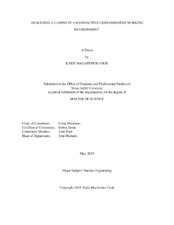Analyzing a Canine in a Radioactive Contaminated Environment
| dc.contributor.advisor | Marianno, Craig | |
| dc.contributor.advisor | Zoran, Debra | |
| dc.creator | Cook, Katie MacArthur | |
| dc.date.accessioned | 2019-10-15T15:41:56Z | |
| dc.date.available | 2019-10-15T15:41:56Z | |
| dc.date.created | 2019-05 | |
| dc.date.issued | 2019-01-11 | |
| dc.date.submitted | May 2019 | |
| dc.identifier.uri | https://hdl.handle.net/1969.1/183850 | |
| dc.description.abstract | When it comes to saving lives after a destructive and catastrophic crisis, urban search and res-cue (USAR) dogs are an essential emergency response component, where each dog can perform the equivalent work of 20 to 30 people. However, based on current practices, if any crisis contained the dispersal of nuclear material, these dogs and their handlers may not be able to take part on their lifesaving missions due to few protective guidelines. In this study a 9.29 m^2 area was sprayed with 200 MBq of ^18F, and a dog executed minor search activities in this contaminated area. Using a positron emission tomography (PET) scanner both internal and external contamination from the dog was localized and quantified. Total contamination on the dog as quantified by the PET scan was 3.4 kBq with external and internal contamination being 2.1 kBq and 1.3 kBq, respectively. Total external dose received to the dog during the exercise was 0.19 µGy, and total internal dose was 1.1 mGy. Overall, this contamination exercise proved a viable method to simulate a radioactive environment safe enough for a dog to participate in but strong enough to create detectable contamination. This will allow researchers to gain insight into health concerns that may arise if a USAR dog took part in a real-world contamination event. | en |
| dc.format.mimetype | application/pdf | |
| dc.language.iso | en | |
| dc.subject | USAR | en |
| dc.subject | canine | en |
| dc.subject | dog | en |
| dc.subject | exposure | en |
| dc.subject | contamination | en |
| dc.subject | external | en |
| dc.subject | internal | en |
| dc.subject | fluorine | en |
| dc.subject | isotope | en |
| dc.subject | radioactive | en |
| dc.subject | emergency response | en |
| dc.subject | radiation | en |
| dc.subject | contaminated | en |
| dc.title | Analyzing a Canine in a Radioactive Contaminated Environment | en |
| dc.type | Thesis | en |
| thesis.degree.department | Nuclear Engineering | en |
| thesis.degree.discipline | Nuclear Engineering | en |
| thesis.degree.grantor | Texas A & M University | en |
| thesis.degree.name | Master of Science | en |
| thesis.degree.level | Masters | en |
| dc.contributor.committeeMember | Ford, John | |
| dc.type.material | text | en |
| dc.date.updated | 2019-10-15T15:41:56Z | |
| local.etdauthor.orcid | 0000-0001-6711-4035 |
Files in this item
This item appears in the following Collection(s)
-
Electronic Theses, Dissertations, and Records of Study (2002– )
Texas A&M University Theses, Dissertations, and Records of Study (2002– )


